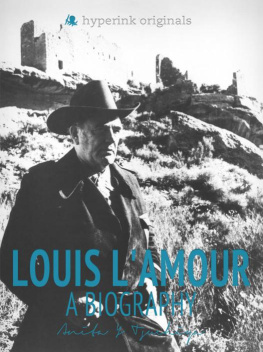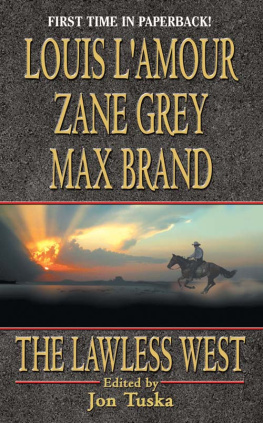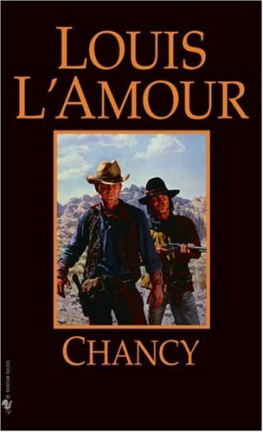Louis L'Amour: A Biography
I.
Louis L'Amour: A Biography
The Last Cowboy
I have told many, yet when I go down that last trail, I know there will be a thousand stories hammering at my skull, demanding to be told.
Louis LAmour was born in the right place, at the right timethe railroad/cattle town of Jamestown, North Dakota just past the turn of the 20th century. By the time of his birth in 1908, much of the surrounding area was well established as farmland. Even further out in Wyoming, Montana, Idaho, and Utah, the wild West was disappearing rapidly, domesticated by barb-wire fencing, railroads, and federal land distribution.
Had he been born even a decade later, Louis would have resided in a very different place. In the 1920s, the cattle industry was decimated by the Midwest bank failures that would eventually lead to the Great Depression. Its not hard to imagine how few frontiersmen would have still been around had LAmour come of age after the Depression instead of in the midst of it.
Fortunately for fans of western fiction, LAmour grew up in a bustling cattle town. Herds of cattle were driven from the rangelands into Jamestown, to be loaded onto rail cars and shipped to meat processing plants in Chicago. This gave young Louis plenty of opportunities to mingle with living members of the Old West .
The Great Depression sent him travelling around the world, across land and sea, further adding to his portfolio of personal exploits. Few authors of fiction could boast of having as much firsthand experience of exotic lands and thrilling adventure as LAmour.
LAmour had been primed to write from childhood, raised in a family of teachers, readers, and writers. He learned the craft of storytelling from a grandfather who had lived through the Civil War, as well as the cattlemen passing through town.
These experiences made LAmour the perfect author to convey the romance and adventure of the frontier era to an industrialized post-war America that had fallen madly in love with the cowboy. Western dramas were the mainstay of the mass-market paperback industry in the 1950s. They were part of the golden age of radio broadcasting in the 1930-40s, and darlings of the Hollywood film industry that followed. With the advent of television, the small screen was the perfect medium for singing cowboys and shoot em up action. In fact, some of the longest-running television dramas have been westerns, such as Gunsmoke , which aired for 635 episodes from 1955-75.
Have Mind, Will Travel
When at the typewriter I am no longer where I sit but am away across the mountains, in ancient cities or on the Great Plains among the buffalo.
Louis Dearborn LaMoore was born on March 22, 1908 to Dr. Louis Charles and Emily Dearborn LaMoore. Louis was the youngest of seven siblingsEdna (b. 1893), Charles Parker (b. 1897), Yale (b. 1899), Emma (b.1902), and twins, Clara and Clarice (b. 1905). The LaMoores also adopted a son, John. Louis changed the spelling of his family name to LAmour when he started submitting poetry and stories for publication.
According to census data , Dr. LaMoore was born in Michigan and moved to North Dakota near Jamestown in the late 1800s. He worked as a veterinarian and machinery salesman for the local farming community. In August 1870, he married Emily Lavis Dearborn, who had been born in Minnesota. Emily had been trained as a teacher, and she shared a love of reading and learning with all her children.
Jamestown was founded in 1872 in conjunction with a small U.S. Army post, Fort Seward, which was given the task of guarding the recently completed extension of the Northern Pacific Railroads northern transcontinental line. Jamestown soon became an important railroad stop for cattle being transported from the western rangelands to the Union Stockyard and meat processing plants in Chicago .
During the shipping season, the town would be filled with ranch hands and trail crews finishing a long cattle drive or heading home from the stockyards. It was during these early days that Louis got his first impressions of the Old West from men who were actually living it.
Another early source of inspiration came from his male relatives. Maternal grandfather, Abraham Truman Dearborn , told young Louis of his experiences as a soldier during the Civil and Indian Wars. Two of his uncles were working cowboys, one a ranch manager and the other a itinerant hand for hire.
Although he did not receive formal schooling beyond the 10th grade, Louis was an avid reader. At home, his parents library consisted of a few hundred books including works by Longfellow, Lowell, Poe, and Whittier. Louis recalled sitting in his fathers lap as a child and the two of them reading Colliers five-volume history series, The Worlds Great Events.
When he got older, LAmour spent hours at the local library, immersing himself in tales of adventure written by Victor Hugo, Alexandar Dumas, Edgar Rice Burroughs, Jack London, and G.A. Henty . He also studied history and natural sciences, his favorite non-fiction topics .
His sister Edna was a librarian and taught him how to use the library for researching topics of interest. Brother Parker worked for a newspaper and later as a secretary for the governor of Oklahoma. From him Louis learned how to write like a journalist, getting right to the point and finishing articles quickly. This technique certainly helped him make a living in the pulp fiction market during the 1920s-40s.
The LaMoores were a close-knit family. Dr. LaMoore and Emily taught all their children that the key to success was a combination of hard work and creative thinking. When Louis reached his teen years, this family philosophy was put to the test by a growing financial crisis faced by North Dakota farmers.
The Maverick Years
Some of the most brilliant conversations Ive heard in my life were in hobo jungles.... I learned a lot about people from men I worked with and knocked around with.
In 1920, after years of providing guarantees on agricultural land sales and crop pricing, the government ended these protections. Prices fell, sparking an epidemic of bank failures and farm foreclosures across the Midwest . North Dakota was hit particularly hard by the bank closures, having already suffered through crop failures over the last few seasons. No one had money for food and utilities, much less luxuries such as new machines.
The financial woes of the agricultural markets snowballed, impacting the national economy until one fateful dayOctober 29, 1929. Stock values on the New York Stock Exchange crashed, costing investors $5 billion in three days. This was the beginning of the Great Depression of the 1930s.
By this time, John and Louis were the only children still living at home. His older brothers, Parker and Yale, and sister Emma had gone on to college and careers. The LaMoores left North Dakota in search of work, moving through Texas, New Mexico, Arizona, California, Nevada, Oregon, and finally, Washington. During this time, Louis took what work he could find : skinning carcasses, bailing hay, mining, and milling lumber.
Traveling the country and working odd jobs, Louis was constantly exposed to interesting personalities and their colorful histories. Many of these were displaced ranchers and cowboys, who were facing the fencing in of the open range and frontier lifestyle. Again, young Louis drank in their tales and later used them as inspiration in writing his stories of the Old West.
According to the The Official Louis LAmour Website , some of the historical figures he met included:
- Bill Tilghman, Marshal of Dodge City
- Chris Madsen, Deputy U.S. Marshal and Sargent, 5th Cavalry
- Emmett Dalton, member of the infamous Dalton outlaw gang






